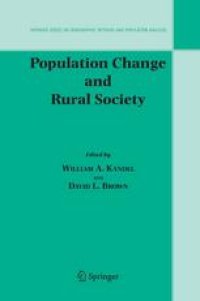
Ebook: Population Change and Rural Society
- Tags: Demography, Sociology, Economic Geography, Human Geography
- Series: The Springer Series on Demographic Methods and Population Analysis 16
- Year: 2006
- Publisher: Springer Netherlands
- Edition: 1
- Language: English
- pdf
CALVIN L. BEALE In considering how to introduce the subject of rural population change in st the 21 Century, I ?nd myself re?ecting on my own experience as a demographer for the U. S. Department of Agriculture. When I arrived at the Department, the post-World War II modernization of farming was well under way. Each year, my colleague Gladys Bowles and I had the unpopular task of announcing how much the farm population had decreased in the prior year. It was hard to say that the phenomenon was someone’s fault. Dramatic reductions in labor requirements per unit of agricultural output were occurring everywhere and not just in the United States. But politically, blame had to be assigned, and whichever political party was not in the White House was certain to place the blame squarely on the current administration. The demographic consequences of this trend were major. In a 22-year period from 1941 to 1962, the net loss of farm population from migration and cessation of farming averaged over a million people per year. It took eight years after the war before an administration was willing to begin to talk about the need to diversify rural employment. By that time, farm residents had already become a minority of rural people. However, well into the 1970s, I continued to receive inquiries from people who still equated rural with farm or who could not envision what rural-nonfarm people did for a living.
This book contains the latest research on social and economic trends occurring in rural America. Conducted by an interdisciplinary and regionally diverse group of social scientists, this original research highlights four major themes transforming contemporary rural areas: population composition change; industrial restructuring and changing livelihoods; changing patterns of rural land use; and areas of persistent disadvantage and emerging opportunity.
Each theme is examined with an expanded overview and geographically varied case studies.
This volume is the first scholarly assessment exclusively focused on rural demographic trends that exploits data from Census 2000. It contributes to knowledge of the interdependency between population change and rural society, and it provides an empirical context for considering policy choices. Enriched by perspectives from demographers, geographers, historians, and, sociologists, this volume is an essential starting point for scholarship on rural demographic change in the 21st Century.